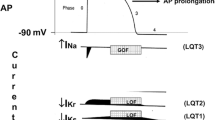Summary
Hypertrophic obstructive cardiomyopathy (HOCM) and long-QT syndrome (LQTS) are cardiac diseases with known genetic disorders. They are inherited in an autosomal-dominant way. From a clinical point of view, both diseases share a disturbed repolarization and the risk of sudden cardiac death. In 1998, during the annual meeting of the German Cardiac Society, we presented the case report of two patients (mother and daughter) with the combination of both diseases, being the first scientific communication on this subject. Both patients experienced sudden cardiac death due to ventricular fibrillation more than 10 years after the first diagnosis of the diseases. Resuscitation resulted in an apallic syndrome in both. The mother died from complications during the course of the apallic syndrome. In contrast to actual therapeutic strategies and data on prophylactic ICD-implantation available today, the daughter received no defibrillator. Sudden death in the presented cases may be due to either disease or their possible malignant association. Thus, the combination of both diseases forms the argument for early prophylactic ICD-implantation in these rare cases. Moleculargenetic studies are needed in large families to elucidate the potential of a common etiology.
Zusammenfassung
Die hypertrophisch obstruktive Kardiomyopathie (HOCM) und das Long-QT-Syndrom (LQTS) gehören zu den molekulargenetisch am besten untersuchten kardialen Erkrankungen. Sie unterliegen einer autosomal-dominanten Vererbung. Beiden Erkrankungen gemeinsam ist die gestörte Repolarisation sowie das Risiko eines plötzlichen Herztodes. Wir stellen in einer kasuistischen Mitteilung zwei Patientinnen (Mutter und Tochter) mit der Kombination beider Erkrankungen vor, die wir als Erstmitteilung in der Literatur auf der Jahrestagung der DGK 1998 präsentierten. Beide Patientinnen erlebten mehr als 10 Jahre nach Diagnosestellung einen plötzlichen Herztod bei Kammerflimmern. Es verblieb als Residualzustand bei beiden Patientinnen ein apallisches Syndrom, an dessen Folgen die Mutter verstarb. Im Gegensatz zu heutigen Therapiestrategien und zur heute verfügbaren Datenlage sahen wir damals noch keine Indikation für die prophylaktische Implantation eines Defibrillators. Als Ursachen für den plötzlichen Herztod kommen beide Erkrankungen oder ihre eventuell besonders maligne Kombination in Betracht. Das gleichzeitige familiäre Vorkommen der Erkrankungen stellt den ersten Hinweis auf eine eventuell gemeinsame Ätiologie dar. Für notwendige molekulargenetische Untersuchungen war die Familie der Patientinnen zu klein. Klinisch ergibt sich ein wichtiges Argument für eine frühzeitige Defibrillator-Implantation bei derartigen Fällen.
Similar content being viewed by others
Author information
Authors and Affiliations
Additional information
Eingegangen: 12. November 2001 Akzeptiert: 15. Januar 2002
Rights and permissions
About this article
Cite this article
Meyer zu Vilsendorf, D., Strunk-Mueller, C., Gietzen, F. et al. Gleichzeitiges Vorliegen einer hypertrophisch-obstruktiven Kardiomyopathie sowie eines Long-QT-Syndroms: eine potentiell maligne Assoziation. Z Kardiol 91, 575–580 (2002). https://doi.org/10.1007/s00392-002-0811-5
Issue Date:
DOI: https://doi.org/10.1007/s00392-002-0811-5




